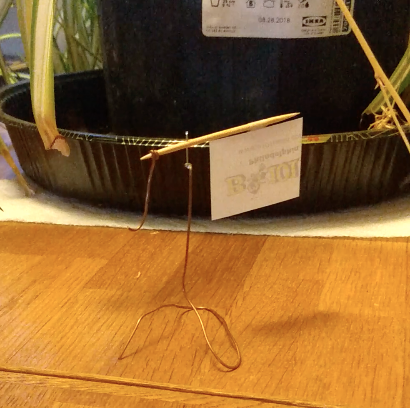
I have come across wonderful work of Felix Hess’s via online documentation of an exhibition Kill Your Timid Notion 08 after reading chapter he wrote in a book called Prerational Intelligence: Adaptive Behavior and Intelligent Systems Without Symbols and Logic, Volume 1, Volume 2
I was inspired by the such a concise, elegant, practical and low tech design of this apparatus to achieve such a sensitivity. The construction in a such a simple and delicate form reminds me of various amazing design of body parts in insects. There is something about this extremely practical design that makes me think of archaic body organ for sensing the environment. Seeing how they move with the air makes me tune my attention on the skin of my cheeks and ears to feel the air movement of the room.
I feel affinity to this device. A long time ago, I did a performance to become a tumbleweed. The premise was to flow in the space with my body along with molecules in the air. I had my vision and hearing totally defused with eye mask and headphone and I was paying very close attention to the movement of the air in the space as it touched my skin. I moved along the air wherever it takes. And I ended up under the staircase circling around. I wanted to be this device. I wanted to have this organ.
I have made one bug that was sensitive to the wind called furin_gate but it need decent amount of movement to be able to trigger this organ. I was exited to imagine how to implement this design to new organ for air.
I made one with materials I had around. Toothpick, paper, tape, sewing pin, copper wire. The device is very simple but very sensitive. All the elements have to be balanced in terms of length, position, attachment and weight. It consists of horizontal pole, flag, pin, counterweight, base pole. Each of these elements have to be just right reletive to eachothers for it to be able to balance well and to be sensitive. (For example: the position and the length of pin is relational to the size, weight and the shape of the flag as well as counterweight) Counterweight was used to fine tune the weight distribution but also to tune the tilt.
The amazing sensitivity of this design really responds to air movements that are too small or too subtle for me to feel. It responds when I walk by, when I open the door, when the heat kicks in, when the sun shines into the room. Even when the room I am in feels still, the device points in one direction. Even if I touch it to disturb, it will go back to the same direction. It was showing the natural habit of air circulation of this particular room that was too gentle for me too notice.
It is such a pleasurable object to have around. It makes me notice changes around me that are too small. Like some of the solar bugs changing sounds to such a minute change of light form the sun that are invisible to my eyes.
I had this bug that was made a while ago that was hanging out in the window sill. One of the connections was broken off and I kept forgetting to repair. I thought it was a good occasion to implement a new organ for this bug. I have thought of few ideas where the air organ will be a small part of the body but for this one, I made the whole bug to turn with the air. The main circuit with solar cells and piezo is attached as a counterweight to the flag. The air movement will shift and turn this bug around and the amount of sunlight the solar cell gets is now depended on the flow of the air in the room as well.
Since the weight of the bug is much heavier then the study, it needed a larger flag to be sensitive. The entire bug became much larger. Because of its weight, the bugs tunes slower than the study but it is still quite sensitive to our movements in the room. I am exited to try designing another iteration of the air organ.